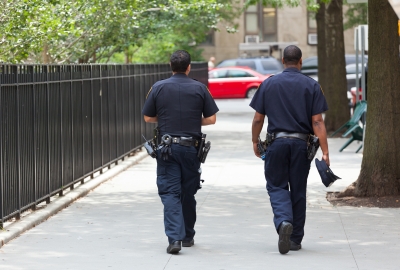
“Understanding the reactions of Black male youth to police”, a project led by Dr. Patrick Shrout (Professor of Psychology), and Crystal Clarke (Doctoral candidate, NYU Psychology), examines how African American, Black immigrant, and White youth in New York City potentially differ in their assessment of police in terms of threat, security, trust in the police, and identification with the police. Their interdisciplinary research team received an IHDSC Seed Award in Spring 2015 to study the psychological and physiological responses of young Black males (age 14 – 22) to the police and evaluate how participants assess the police explicitly and implicitly. Alex Clothier and Chris Barker spoke to Dr. Shrout and Crystal Clarke about their ongoing project.
Could you tell us about the origins of your project?
Clarke: I came to Pat’s lab in my 3rd year in the Social Psychology program with a particular interest in studying policing and how young boys think about the police. In working with Pat and in trying to conceive of an idea of how to approach it in a psychological way, we started talking about identity. My parents are from Guyana so immigrant identity has always just been naturally interesting to me, but this was an opportunity to approach it from an academic standpoint and really explore what the psychological mechanisms are in terms of what underlies how identity informs attitudes towards the police.
Shrout: It turns out I’ve learned a lot from this project. Crystal started teaching me, from the beginning, particularly about Black identity. This narrative that Diane Hughes has studied about how parents talk to children about civil rights and about institutions, is not a narrative that immigrants typically learn. So we wrote about this project thinking it was going to be confirmatory. For me, it’s turned out to be much more a discovery about the complexities of black identity.
Your study launched in 2015 when there was considerable media attention on encounters between police and Black men. How did the national conversation shape this study?
Clarke: Trayvon Martin was the first big story while in graduate school that really caught my attention. I figured if I had this opportunity, as the only Black person in the department at that point, to study something that was meaningful and had a broader impact, I wanted to spend the time studying something that was relevant to what was going on outside of the Ivory Tower.
Shrout: So that started a conversation. There is this research about police determining whether or not [he picks up a pen] this is a weapon or a pen, but not many people had studied the reverse. We were thinking that if someone was looking nervous because they’re viewing the police officer as a source of threat that nervousness might be reinterpreted as aggression, so it seemed really important to study and I think it still is.
Your IHDSC Seed Award proposal included a sociologist, developmental psychologists, and a social psychologist. How did you incorporate their expertise into your research design?
Clarke: Diane Hughes played a huge role in how we conceived the topic. Essentially what we’re looking at is what are racial and ethnic differences in the way people understand police specifically in terms of whether they think of the police as a source of threat versus a source of safety. Diane Hughes’ theory on ethnic racial socialization suggests that there may be ethnic differences between African Americans and children of immigrants, ethnic differences in the way people inherit narratives about race which naturally may include narratives about the police.
But then there is Amanda Geller, a sociologist, and we reached out to her because she had done a lot of work with Tom Tyler. He has promoted this conversation on trust and confidence in the police aside from general evaluations of the police as “good” and “bad.” Amanda Geller worked with Tom and did her own research on community policing in New York and we thought she would be perfect.
Shrout: I think we found her when we were just doing the literature review. She had just published a paper that was a big survey of youth in New York and lo and behold she was at NYU!
Amanda Geller’s study involved a phone survey conducted by an external firm, whereas yours involves participants coming to a lab and participating in a much wider range of measures. Could you tell us a little bit about those measures and that process?
Clarke: People may hold explicit attitudes towards the police that may not exist implicitly based on these ethnic-racial socialization narratives. Part of our study occurs online where people share their general structural ideas of how police relate to other roles, but another part of our work is a laboratory study where we ask young boys ages 14 to 25 who identify as either African American, Black immigrant, or White to come into the lab. It’s a three-part experience where we assess their implicit attitudes towards the police by having them take an Implicit Association Test (IAT).
As Harvard’s Project Implicit explains it, “The IAT measures the strength of associations between concepts (e.g., Black people, gay people) and evaluations (good or bad) or stereotypes (athletic or clumsy). The main idea is that making a response is easier when closely related items share the same response key.” Stimuli are expected to be classified more quickly when the pairings match the individual’s automatic associations.
Our IAT is different in that it looks at implicit attitudes towards the police, but in terms of implicit associations with threat versus security. We have that IAT as well as an evaluative, very basic “good or bad” IAT. That’s our main measure of looking at these implicit or unconscious attitudes towards the police that may not be expressed explicitly.
There may be young Black men who, because they grew up in New York City may have heard narratives about the police that are negative and thus may hold explicit negative attitudes towards the police, but because they are children of immigrants or have not have personal encounters with the police, they may not hold negative implicit attitudes or threat feelings towards the police. We’re really trying to parse out how these attitudes manifest and how these young boys are psychologically experiencing the police.

[Editor’s note: The team uses special laboratory equipment to measure response times as a way to measure implicit bias by flashing images of positive or negative items and individuals from different racial/ethnic backgrounds. You can learn more about attitudes, implicit and explicit bias, and take various IATs at Harvard’s Project Implicit site]
Shrout: Our hypothesis was that an immigrant might not have been exposed as much negativity about the police, however because there is so much in the media that they might say, “well, look at what’s going on in Ferguson” so that their explicit statements might look pretty negative, but that their implicit associations would be less so. What we’re really curious about is above and beyond evaluative good or bad, “I feel positive or negative about the police, do I have some association with the police that is particular to threat, am I feeling psychologically or physiologically threatened by the police?”
I’ll be interested in whatever the results are and we’re making sure that we’re going to learn from these data. Crystal and I meet once a week to talk and this is what I say: don’t get distracted by taking a peek at the data. Let’s finish. Let’s finish getting the data, and she can tell you I do a pep talk…
Clarke: Every week….
Shrout: …keep collecting data!
Imagine you’ve completed the study and you’re invited to a meeting with local organizations, neighbors, and the NYPD to address the relationship between the community and the police. What would you hope to add to this hypothetical conversation?
Clarke: When I hear the stories of police in conflict — fatal at times — with young Black men, I often hear this narrative about police feeling threatened by unarmed Black men. My work speaks to whether we can identify or document in all of these different ways that there is a segment of society that is psychologically and physiologically experiencing the police as a source of threat given that we understand, at least colloquially, that the police are institutional authorities who are there to protect and serve. If we’re finding that there’s a segment of society who are not seeing the police in that light, who really see them as psychological and or physical threats, I think that really disrupts this conversation about who is being threatened in these interactions. If we can really spark a conversation with police officers and community members, about what the real experience of these young Black boys are when they’re in the street, if we can document what that experience is for these young boys, I think that opens up the conversation in a way that we haven’t yet had about threat in those moments. For me, that adds another layer to the conversation.
IHDSC’s Seed Award program supports new NYU research projects that bridge multiple domains of expertise and address complex social problems. Calls for Seed Award applications are released each Fall. Visit IHDSC’s Initiatives page to learn more.

